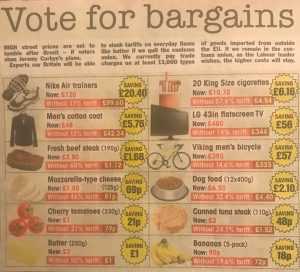This piece of maths in The Sun was all over Twitter this week. It was retweeted and praised by MP Jacob Rees Mogg. The maths in it is wrong. Wrong, but interesting.

A lot of people tried to correct it on Twitter, but Twitter is not the place for explaining mathematical content.
The Sun has tried to calculate the cost of items – the tariff percentages. I’m not going to talk about things like tariff calculations being based on other things apart from the retail price, or the fact that some of these items are from tariff-free countries. I am merely going to talk about the common percentage misconception and why maths matters.
The easiest way to see the error The Sun have made is by looking at the calculation for butter.

This seems to make sense. 50% of £2 is £1, so take £1 off the price, and presto. Except, working backwards we can see that this doesn’t work.
If butter cost £1, and we applied a 50% tariff to it, the final cost would be £1.50. The maths doesn’t stand up when working in reverse.
How should we do it?
I think the easiest way to think about this is to call the original price 100%. After the 50% tariff has been applied our new price (£2) represents 150%. To find 50% of this new amount, we actually have to divide £2 by 3, as . We can then take away our 50%.
The new price should be £1.33 (and a third).
Does this matter?
Well, kind of. I don’t think anyone would have been less convinced by the new, accurate figures. I do, however, think that we need to be careful about promoting sloppy mathematical thinking in the public arena. At the very least, it is indeed an example of ‘real life’ maths.
Several people on Twitter have suggested it as a nice activity to do in lesson, to correct the figures. However, I would be careful about the surface of the problem distracting from what is intended to be learnt.
I think The Sun could do well to offer a correction, along with a page explaining the mathematics.

Worth to noting that there are at least two other kinds of error in this article (and the thinking behind it):
– It presumes, incorrectly, that import tariffs are added to the retain price. They aren’t, they are paid on the import price *before* all subsequent extra costs (e.g. distribution, VAT, etc) as added.
– It presumes that the UK will simply drop *all* import tariffs post-Brexit. For a variety of economic and political reasons – and also because of WTO rules – this is simply not going to happen.